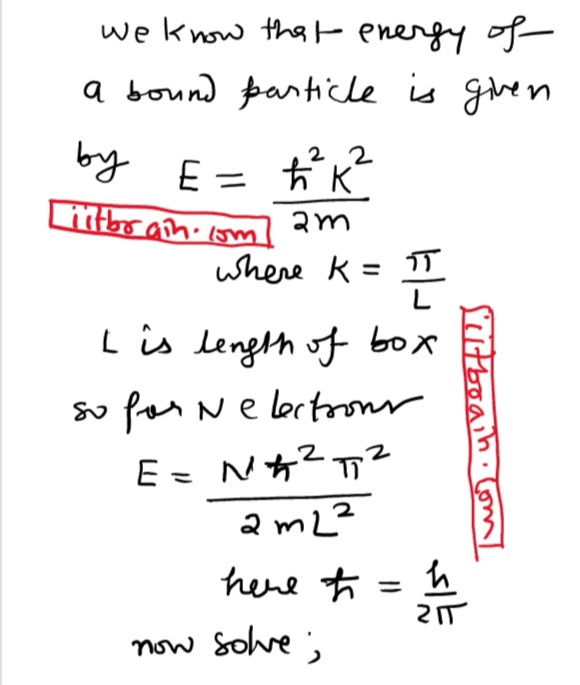11 - Modern Physics Questions Answers
A point source of light is placed at the centre of curvature
of a hemispherical surface. The radius of curvature is r
and the inner surface is completely reflecting. Find the
force on the hemisphere due to the light falling on it if
the source emits a power W.
There are N numbers of electrons present in a one-dimensional box of length L. Assuming no coulombic interactions are present, find the ground-state energy of the N-particle system. N is an even number and mass of each electron is m. All electrons have a definite momentum, p, and their collisions with the box are perfectly elastic.

Sir
Does time exist or is it just an illusion .
Please tell.
I am not a scientist yet many scientists including Einstein explain time as an illusion, so it can be said.
Consider an electron trapped in an infinite well whose width is 98.5 pm. If it is in a state with n = 15, what are (i) its energy? (ii) the uncertainty in its momentum? (iii) the uncertainty in its position?
a toy car of mass 500g travels with a uniform velocity of 25m/s for 5 seconds, the brakes are then applied and the car is uniformly retarded and comes to rest in further 10s calculate the retardation
use v = u + at
u = 25, v = 0 and t = 10
when we throw a shotput ball it covers a very less distance and when we throw a rubber ball it covers a larger distance.
the reason behind this well known to everyone that the shotput ball has more mass as compared to the rubber ball.
But when throw a paper ball it covers the least diatance why?
for this motion 0-R = ma
so retardation = R/m
for less mass retardation will be more
in the case of shotput
mu + impulse given = mv
so v = u + {impulsegiven/m}
so more mass will gain less velocity in comparison to less mass on applying same impulse.
the half life of radium is 1620 year & its atomic weight is 226gm/mole. the number of atoms that will decay from its 1g sample per second is
1) 3.16 x 1010
2)3.6 x 1012
3) 3.1 x 1015
4) 31.1 x 1015
for radioactivity we know that it is a first order process
so dN/dt = -λN
so dN/1 = -[0.6932/(1620*3.1*107)]*(1/226)*6.023*1023
solve now
A RADIOACTIVE SUBSTANCE EMITS n BETA PARTICLES IN THE FIRST 2 SECONDS & 0.5 n BETA PARTICLES IN THE NEXT 2 SECONDS . THE MEAN LIFE OF THE SAMPLE IS
ANS 2/(ln2) s
A RADIOACTIVE SUBSTANCE EMITS n BETA PARTICLES IN THE FIRST 2 SECONDS & 0.5 n BETA PARTICLES IN THE NEXT 2 SECONDS. Definitely by definition its half life will be 2 sec.
so mean life = half life / ln2 This is the relation between mean life and half life.
A NUCLEUS OF MASS NO. 220, INITIALLY AT REST , EMITS AN .α PARTICLE . IF THE Q VALUE OF THE Rxn IS 5.5MeV THE ENERGY OF THE EMITTED α PARTICLE WILL BE ??
ANS 5.4 MeV
5.5*216/220 = 216/40 = 5.4 MeV here 216 is the mass of nucleus after ejecting α particle.
The activity of a freshly prepared radioactive sample is 10^10 disintegrations per second, whose mean life is 10^9 sec.
The mass of an atom of this radioisotope is 10 ^ -25 kg. The mass (in mg) of the radioactive sample is
dN/dt = -λN
1010 = -[1/109] N λ = 1/mean life
so N = 1019 disintegration
so mass of radioisotope = 1019 *10-25 = 10-6 Kg = 1 mg
